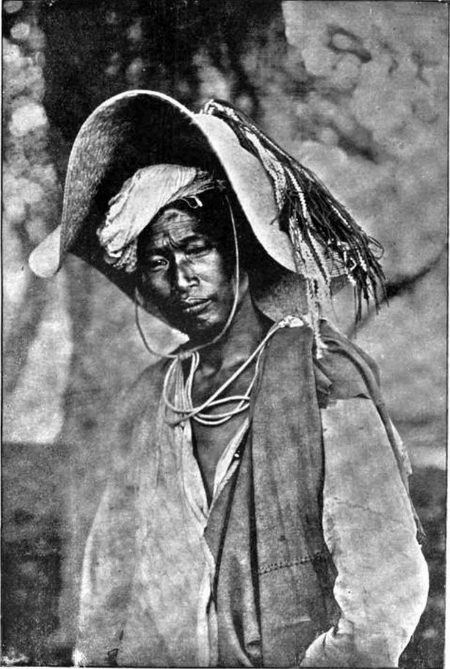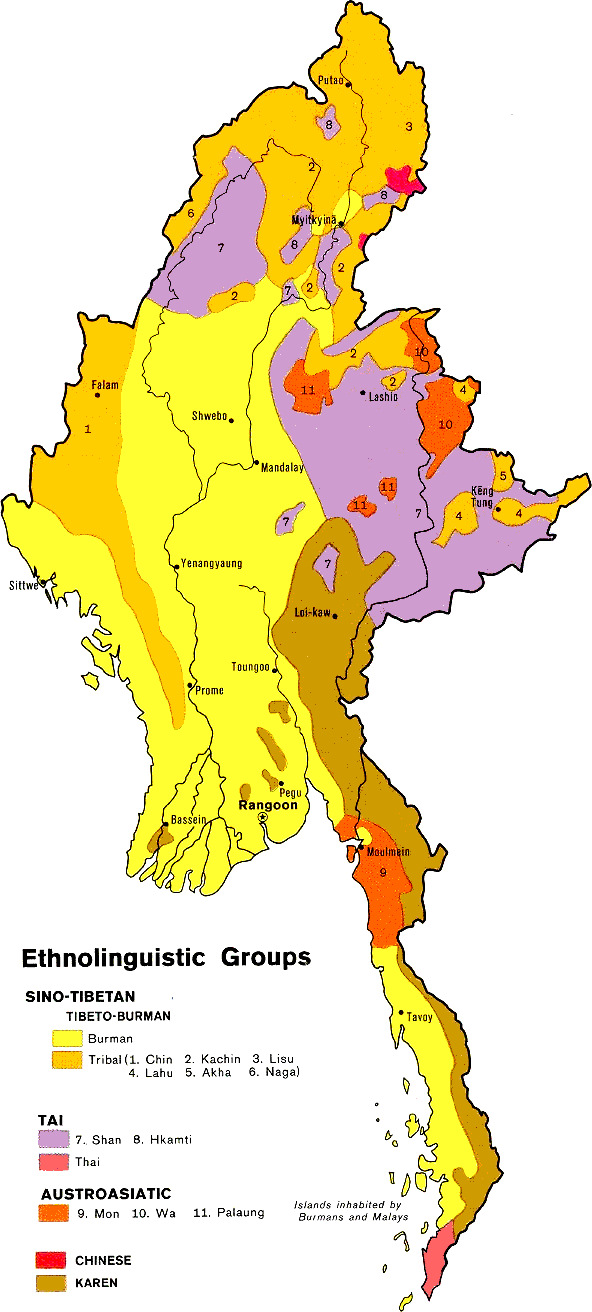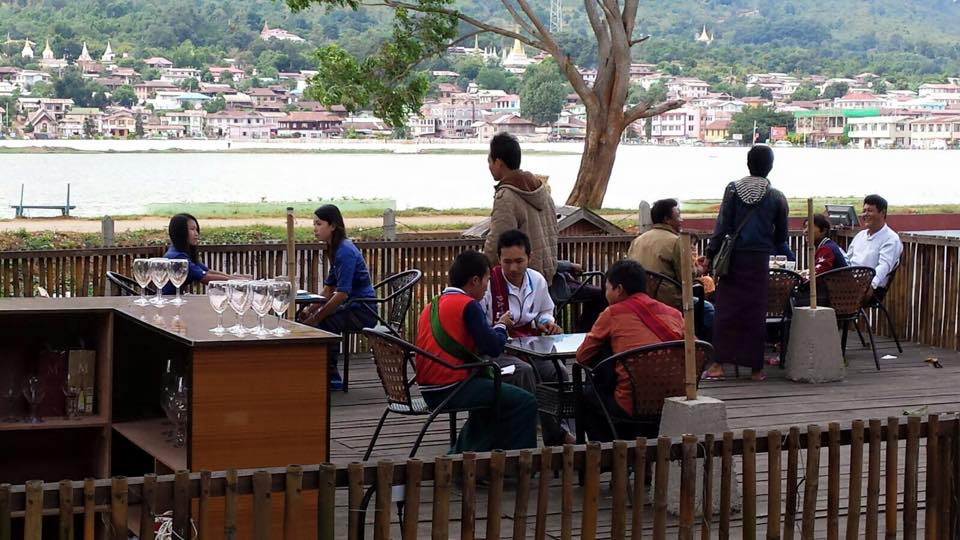|
Taungyo
The Taungyo ( ''Tauñyoù lumyoù'') are a sub-ethnic group of the Bamar people living primarily in Shan State and centered on Pindaya. Language They speak Taungyo (တောင်ရိုးစကား Tauñyoùs̱áḵà), a Tavoyan dialect of the Burmese language. Taungyo has 89% lexical similarity with standard Burmese, and is also closely related to Intha-Danu language, Danu, Intha and Rakhine language, Rakhine. A sample of Taungyo dialect vocabulary include the following: *red - ''anak (အနီ)'' *high - ''amrang'' () *eye - ''myak-sai'' () *light - ''lang'' () References {{Ethnic groups in Burma Ethnic groups in Myanmar Bamar people ... [...More Info...] [...Related Items...] OR: [Wikipedia] [Google] [Baidu] |
Shan State
Shan State (, ; , ) is a administrative divisions of Myanmar, state of Myanmar. Shan State borders China (Yunnan) to the north, Laos (Louang Namtha Province, Louang Namtha and Bokeo Provinces) to the east, and Thailand (Chiang Rai Province, Chiang Rai, Chiang Mai Province, Chiang Mai and Mae Hong Son Provinces) to the south, and five administrative divisions of Myanmar in the west (Kachin State, Mandalay Region, Kayin State, Kayah State, and Sagaing Region). The largest of the 14 administrative divisions by land area, Shan State covers 155,800 km2, almost a quarter of the total area of Myanmar. The state gets its name from the Burmese name for the Tai peoples: "Shan people". The Tai (Shan) constitute the majority among several ethnic groups that inhabit the area. Shan State is largely rural, with only three cities of significant size: Lashio, Kengtung, and the capital, Taunggyi. Taunggyi is northeast of the nation's capital Naypyitaw. The Shan state, with many ethnic groups ... [...More Info...] [...Related Items...] OR: [Wikipedia] [Google] [Baidu] |
Burmese Language
Burmese (; ) is a Tibeto-Burman languages, Tibeto-Burman language spoken in Myanmar, where it is the official language, lingua franca, and the native language of the Bamar people, Bamar, the country's largest ethnic group. Burmese dialects are also spoken by the indigenous tribes in Bangladesh's Chittagong Hill Tracts, India's Mizoram, Manipur, Tripura states and the Burmese diaspora. The Constitution of Myanmar officially refers to it as the Myanmar language in English, though most English speakers continue to refer to the language as ''Burmese'', after ''Burma''—a name with co-official status until 1989 (see Names of Myanmar). Burmese is the most widely-spoken language in the country, where it serves as the lingua franca. In 2019, Burmese was spoken by 42.9 million people globally, including by 32.9 million speakers as a first language, and an additional 10 million speakers as a second language. A 2023 World Bank survey found that 80% of the country's population speaks Burmese ... [...More Info...] [...Related Items...] OR: [Wikipedia] [Google] [Baidu] |
Ethnic Groups In Myanmar
Myanmar (Burma) is an ethnically diverse nation with 135 distinct ethnic groups officially recognised by the Burmese government, which are grouped into eight "major national ethnic races" — the Bamar, Kayin, Arakanese, Shan, Mon, Chin, Kachin, and Karenni. The Bamar (Burman) comprise about 68% of the population, and the rest belonging to numerous major and minor ethnic and language groups. The "major national ethnic races" are grouped primarily according to geographic region rather than ethnolinguistic affiliation. For example, the Shan national race includes 33 ethnic groups that live in Shan State and speak languages in at least four language families. Myanmar's contemporary politics around ethnicity surround treating ethnicity as a minoritising discourse, pitting a "pan-ethnic" national identity against minority groups. Often ethnicity identities in practice are flexible — sometimes as flexible as simply changing clothes — in part due to a lack of religious or et ... [...More Info...] [...Related Items...] OR: [Wikipedia] [Google] [Baidu] |
Tavoyan Dialects
Tavoyan or Dawei (, abbreviated ) is a divergent dialect of Burmese is spoken in Dawei (Tavoy), in the coastal Tanintharyi Region of southern Myanmar (Burma). Tavoyan speakers self-identify as Bamar, and are classified by the Burmese government as a subgroup of the Bamar. Approximately 400,000 people speak Tavoyan. Burmese speakers further south speak the Palaw and Myeik dialects. Tavoyan and Burmese have 87% lexical similarity. Distinct phonological features of Tavoyan have been strengthened by language contact with the Karenic languages. Tavoyan prosody is markedly different from Standard Burmese, especially with respect to rhythm and intonation. Similar to Karen speakers, Tavoyan speakers do not draw out their vowels like Standard Burmese speakers. Tavoyan retains an medial that has since merged into the medial in standard Burmese. Also, voicing can only occur with unaspirated consonants in Tavoyan, whereas in standard Burmese, voicing can occur with both aspirated an ... [...More Info...] [...Related Items...] OR: [Wikipedia] [Google] [Baidu] |
Tavoyan Dialect
Tavoyan or Dawei (, abbreviated ) is a divergent dialect of Burmese is spoken in Dawei (Tavoy), in the coastal Tanintharyi Region of southern Myanmar (Burma). Tavoyan speakers self-identify as Bamar, and are classified by the Burmese government as a subgroup of the Bamar. Approximately 400,000 people speak Tavoyan. Burmese speakers further south speak the Palaw and Myeik dialects. Tavoyan and Burmese have 87% lexical similarity. Distinct phonological features of Tavoyan have been strengthened by language contact with the Karenic languages. Tavoyan prosody is markedly different from Standard Burmese, especially with respect to rhythm and intonation. Similar to Karen speakers, Tavoyan speakers do not draw out their vowels like Standard Burmese speakers. Tavoyan retains an medial that has since merged into the medial in standard Burmese. Also, voicing can only occur with unaspirated consonants in Tavoyan, whereas in standard Burmese, voicing can occur with both aspirated and una ... [...More Info...] [...Related Items...] OR: [Wikipedia] [Google] [Baidu] |
Bamar
The Bamar people (Burmese language, Burmese: ဗမာလူမျိုး, ''ba. ma lu myui:'' ) (formerly known as Burmese people or Burmans) are a Sino-Tibetan-speaking ethnic group native to Myanmar (formerly known as Burma). With an estimated population of around 35 million people, they are the largest ethnic group in Myanmar, accounting for 68.78% of the country's total population. The geographic homeland of the Bamar is the Irrawaddy River, Irrawaddy River basin. The Bamar speak the Burmese language which serves as the national language and lingua franca of Myanmar. Ethnonyms In the Burmese language, ''Bamar'' (, also transcribed ''Bama'') and ''Myanmar'' (, also transliterated ''Mranma'' and transcribed ''Myanma'') have historically been interchangeable Endonym and exonym, endonyms. Burmese is a Diglossia, diglossic language; "Bamar" is the diglossic low form of "Myanmar," which is the diglossic high equivalent. The term "Myanmar" is extant to the early 1100s, first ... [...More Info...] [...Related Items...] OR: [Wikipedia] [Google] [Baidu] |
Intha People
The Insar (, ; , also spelt Innsar) are members of a Tibeto-Burman languages, Tibeto-Burman ethnic group living around Inle Lake. There are around 100,000 to 200,000 Insar. Origins The origins of the Insar are disputed; the Insar believe their ancestors arrived from the southern tip of modern-day Myanmar (Tanintharyi Region). A commonly held theory is that the Insar fled from southern Myanmar during the 14th century; the ruling Shan saophas forbade them from settling on the land, which forced the Insar to instead settle on Inle Lake. To this day, the Insar primarily live in four cities bordering the lake, in numerous small villages along the lake's shores, and on the lake itself. The entire lake area is in Nyaung Shwe township. Language The Insar speak a divergent dialect of Burmese language, Burmese. Colonial observers noted that the Insar spoke a language resembling Burmese, with a Shan language, Shan accent. Unlike other dialects of Burmese, the Insar language does not e ... [...More Info...] [...Related Items...] OR: [Wikipedia] [Google] [Baidu] |
Bamar People
The Bamar people ( Burmese: ဗမာလူမျိုး, ''ba. ma lu myui:'' ) (formerly known as Burmese people or Burmans) are a Sino-Tibetan-speaking ethnic group native to Myanmar (formerly known as Burma). With an estimated population of around 35 million people, they are the largest ethnic group in Myanmar, accounting for 68.78% of the country's total population. The geographic homeland of the Bamar is the Irrawaddy River basin. The Bamar speak the Burmese language which serves as the national language and lingua franca of Myanmar. Ethnonyms In the Burmese language, ''Bamar'' (, also transcribed ''Bama'') and ''Myanmar'' (, also transliterated ''Mranma'' and transcribed ''Myanma'') have historically been interchangeable endonyms. Burmese is a diglossic language; "Bamar" is the diglossic low form of "Myanmar," which is the diglossic high equivalent. The term "Myanmar" is extant to the early 1100s, first appearing on a stone inscription, where it was used as a cul ... [...More Info...] [...Related Items...] OR: [Wikipedia] [Google] [Baidu] |
Pindaya
Pindaya ( ''Pìñṯáyá myoú'') is the capital of the Danu Self-Administered Zone in Shan State, east-central Myanmar. It is located in Pindaya Township. Mainly famous for its limestone caves called Pindaya Caves where thousands of Buddha Siddhartha Gautama, most commonly referred to as the Buddha (),* * * was a wandering ascetic and religious teacher who lived in South Asia during the 6th or 5th century BCE and founded Buddhism. According to Buddhist legends, he was ... images have been consecrated for worship over the centuries, it is also one of the towns that host an itinerant market every fifth day. Etymology According to local legend, the term ''Pindaya'' is a corruption of the word Pinguya, which translates to ''Taken the Spider'' in Burmese. The name arose from the legend that there was once a large spider which resided in the caves and it had captured a local princess. The princess was rescued when the giant spider was slain by a prince using a bow a ... [...More Info...] [...Related Items...] OR: [Wikipedia] [Google] [Baidu] |
Theravada Buddhism
''Theravāda'' (; 'School of the Elders'; ) is Buddhism's oldest existing school. The school's adherents, termed ''Theravādins'' ( anglicized from Pali ''theravādī''), have preserved their version of the Buddha's teaching or '' Dhamma'' in the Pāli Canon for over two millennia. The Pāli Canon is the most complete Buddhist canon surviving in a classical Indian language, Pāli, which serves as the school's sacred language and ''lingua franca''.Crosby, Kate (2013), ''Theravada Buddhism: Continuity, Diversity, and Identity'', p. 2. In contrast to Mahāyāna and Vajrayāna, Theravāda tends to be conservative in matters of doctrine ('' pariyatti'') and monastic discipline ('' vinaya''). One element of this conservatism is the fact that Theravāda rejects the authenticity of the Mahayana sutras (which appeared onwards). Consequently, Theravāda generally does not recognize the existence of many Buddhas and bodhisattvas believed by the Mahāyāna school, such as Amitābha a ... [...More Info...] [...Related Items...] OR: [Wikipedia] [Google] [Baidu] |
Danu People
The Danu people () are a government-recognized ethnic group in Myanmar (Burma), predominantly populating the areas near the Pindaya Caves in Shan State. They speak the Danu language, which is closely related to Burmese. Etymology The name ''Danu'' derives from the Pali term , which means "archer" or "bow." The term is a reference to the legend of Prince Kumarabhaya, whose bow and arrow rescued seven princesses trapped in the caves by a giant spider. Origins Some oral traditions trace the ancestry of the Danu to the intermarriages of Burmese men and Shan women in the 16th century, coinciding with the expansionist policies of King Bayinnaung, who oversaw the establishment of Burmese administrative posts throughout the kingdom, including in Shan city-states. Notable Danu people * Aung Myat - former Chief Minister of Shan State Shan State (, ; , ) is a administrative divisions of Myanmar, state of Myanmar. Shan State borders China (Yunnan) to the north, Laos (Loua ... [...More Info...] [...Related Items...] OR: [Wikipedia] [Google] [Baidu] |




